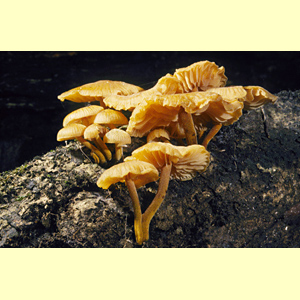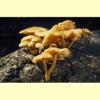
images/Heimiomyces/xeromphalina.jpg
Small to medium (sometimes large) agaric, growing on the ground, on litter or mulch or on wood, with a white spore print. Pileus yellow or brown, dry or moist. Lamellae adnate, sinuate or notched or subdecurrent, yellow to brown. Stipe central, dry and entirely pruinose to velvety. Partial veil remnants absent. Spores hyaline, amyloid, smooth; germ pore absent. Cheilocystidia present, often nodulose, as are terminal elements of the pileipellis. Lamellar trama regular or interwoven. Pileipellis a trichoderm, rarely a cutis. Upper pileus trama sometimes with a well-marked gelatinous layer. Clamp connections present.
The tough texture of
Heimiomyces resembles
Marasmius, but the latter has a smooth stipe, non-amyloid spores and a pileipellis that is a hymeniderm. Among other white-spored genera with a dry, pruinose to velvety stipe and non-decurrent lamellae:
Gymnopus has non-amyloid spores;
Cyptotrama aspratum has a cobwebby partial veil when young; and
Flammulina has a viscid pileus.
Xeromphalina is closely related (sharing the amyloid spores), but the single Australian species is very small, and has decurrent lamellae and an umbilicate pileus. Among other agarics with hyaline, smooth amyloid spores,
Mycena generally has a cutis of nodulose hyphae (rather than the trichoderm typical of
Heimiomyces), and
Porpoloma has a cutis of smooth hyphae and the cheilocystidia, (when present) are not nodulose.
Heimiomyces Singer, Lloydia 5: 128 (1942).
Several species:
Heimiomyces flavobrunneus and
H. tenuipes (=
Xeromphalina).
Porpoloma penetrans also belongs in Heimiomyces.
Characters of this genus in the key were also taken from the Papua New Guinea species H. neovelutipes.
W.A., S.A., Qld, N.S.W. and Vic. (and probably also N.T.).
In native forests.
Mainly on wood, sometimes on litter, occasionally on the ground (perhaps attached to buried wood).
Saprotrophic.
Grgurinovic, C.A. (1997a),
Larger Fungi of South Australia. The Botanic Gardens of Adelaide and State Herbarium and The Flora and Fauna of South Australia Handbooks Committee, Adelaide. [
Description and
Microcharacters of
Porpoloma penetrans (which belongs in
Heimiomyces)]
Hood, I.A. (2003), An Introduction to Fungi on Wood in Queensland. University of New England, School of Environmental Sciences and Natural Resources Management, Armidale. [Description and B&W Illustration of H. tenuipes (as Xeromphalina)]
Horak, E. (1979d), Xeromphalina and Heimiomyces in Indomalaya and Australasia, Sydowia. 32: 131–153. [Key to Australasian and Indomalayan species of the genus, and Description, Microcharacters and B&W Illustration of H. flavobrunneus and five other species including H. neovelutipes]
Pegler, D.N. (1977), A preliminary agaric flora of East Africa, Kew Bull., Addit. Ser. 6: 1–615. [Description, B&W Illustration and Microcharacters of H. tenuipes (as Xeromphalina) from Africa]
Pegler, D.N. (1997), The Larger Fungi of Borneo. Natural History Publications, Kota Kinabalu. [Illustration of H. tenuipes (as Xeromphalina) from Borneo]
Young, A.M. (2005b), A Field Guide to the Fungi of Australia. University of New South Wales Press, Sydney. [Description and B&W Illustration of H. tenuipes (as Xeromphalina)]


